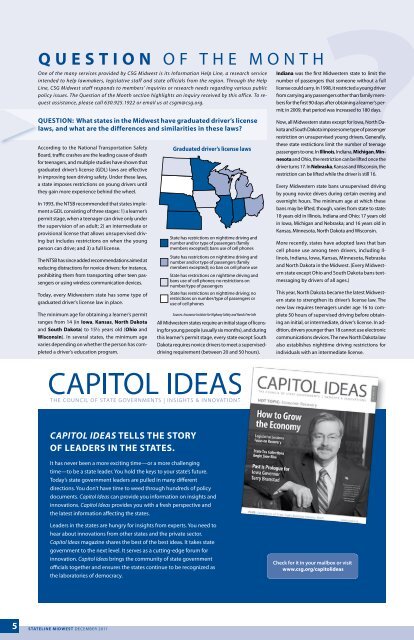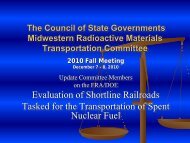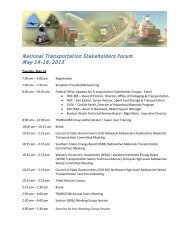Stateline Midwest - CSG Midwest
Stateline Midwest - CSG Midwest
Stateline Midwest - CSG Midwest
Create successful ePaper yourself
Turn your PDF publications into a flip-book with our unique Google optimized e-Paper software.
Question of the Month<br />
One of the many services provided by <strong>CSG</strong> <strong>Midwest</strong> is its Information Help Line, a research service<br />
intended to help lawmakers, legislative staff and state officials from the region. Through the Help<br />
Line, <strong>CSG</strong> <strong>Midwest</strong> staff responds to members’ inquiries or research needs regarding various public<br />
policy issues. The Question of the Month section highlights an inquiry received by this office. To request<br />
assistance, please call 630.925.1922 or email us at csgm@csg.org.<br />
Question: What states in the <strong>Midwest</strong> have graduated driver’s license<br />
laws, and what are the differences and similarities in these laws?<br />
According to the National Transportation Safety<br />
Board, traffic crashes are the leading cause of death<br />
for teenagers, and multiple studies have shown that<br />
graduated driver’s license (GDL) laws are effective<br />
in improving teen driving safety. Under these laws,<br />
a state imposes restrictions on young drivers until<br />
they gain more experience behind the wheel.<br />
In 1993, the NTSB recommended that states implement<br />
a GDL consisting of three stages: 1) a learner’s<br />
permit stage, when a teenager can drive only under<br />
the supervision of an adult; 2) an intermediate or<br />
provisional license that allows unsupervised driving<br />
but includes restrictions on when the young<br />
person can drive; and 3) a full license.<br />
The NTSB has since added recommendations aimed at<br />
reducing distractions for novice drivers: for instance,<br />
prohibiting them from transporting other teen passengers<br />
or using wireless communication devices.<br />
Today, every <strong>Midwest</strong>ern state has some type of<br />
graduated driver’s license law in place.<br />
The minimum age for obtaining a learner’s permit<br />
ranges from 14 (in Iowa, Kansas, North Dakota<br />
and South Dakota) to 15½ years old (Ohio and<br />
Wisconsin). In several states, the minimum age<br />
varies depending on whether the person has completed<br />
a driver’s education program.<br />
Graduated driver’s license laws<br />
State has restrictions on nighttime driving and<br />
number and/or type of passengers (family<br />
members excepted); bans use of cell phones<br />
State has restrictions on nighttime driving and<br />
number and/or type of passengers (family<br />
members excepted); no ban on cell phone use<br />
State has restrictions on nighttime driving and<br />
bans use of cell phones; no restrictions on<br />
number/type of passengers<br />
State has restrictions on nighttime driving; no<br />
restrictions on number/type of passengers or<br />
use of cell phones<br />
Sources: Insurance Institute for Highway Safety and Hands Free Info<br />
All <strong>Midwest</strong>ern states require an initial stage of licensing<br />
for young people (usually six months), and during<br />
this learner’s permit stage, every state except South<br />
Dakota requires novice drivers to meet a superviseddriving<br />
requirement (between 20 and 50 hours).<br />
Indiana was the first <strong>Midwest</strong>ern state to limit the<br />
number of passengers that someone without a full<br />
license could carry. In 1998, it restricted a young driver<br />
from carrying any passengers other than family members<br />
for the first 90 days after obtaining a learner’s permit;<br />
in 2009, that period was increased to 180 days.<br />
Now, all <strong>Midwest</strong>ern states except for Iowa, North Dakota<br />
and South Dakota impose some type of passenger<br />
restriction on unsupervised young drivers. Generally,<br />
these state restrictions limit the number of teenage<br />
passengers to one. In Illinois, Indiana, Michigan, Minnesota<br />
and Ohio, the restriction can be lifted once the<br />
driver turns 17. In Nebraska, Kansas and Wisconsin, the<br />
restriction can be lifted while the driver is still 16.<br />
Every <strong>Midwest</strong>ern state bans unsupervised driving<br />
by young novice drivers during certain evening and<br />
overnight hours. The minimum age at which these<br />
bans may be lifted, though, varies from state to state:<br />
18 years old in Illinois, Indiana and Ohio; 17 years old<br />
in Iowa, Michigan and Nebraska; and 16 years old in<br />
Kansas, Minnesota, North Dakota and Wisconsin.<br />
More recently, states have adopted laws that ban<br />
cell phone use among teen drivers, including Illinois,<br />
Indiana, Iowa, Kansas, Minnesota, Nebraska<br />
and North Dakota in the <strong>Midwest</strong>. (Every <strong>Midwest</strong>ern<br />
state except Ohio and South Dakota bans textmessaging<br />
by drivers of all ages.)<br />
This year, North Dakota became the latest <strong>Midwest</strong>ern<br />
state to strengthen its driver’s license law. The<br />
new law requires teenagers under age 16 to complete<br />
50 hours of supervised driving before obtaining<br />
an initial, or intermediate, driver’s license. In addition,<br />
drivers younger than 18 cannot use electronic<br />
communications devices. The new North Dakota law<br />
also establishes nighttime driving restrictions for<br />
individuals with an intermediate license.<br />
5 STATELINE MIDWEST December 2011








